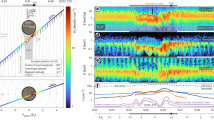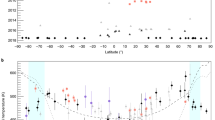Abstract
Current theoretical models of Saturn's ionosphere are similar to those of Jupiter's because of the gross similarity of their upper atmospheres. In the case of Jupiter, the theoretical models can be fitted reasonably well to ionospheric electron density profiles1,2 obtained from the Pioneer and Voyager radio occultation experiments3–5. In contrast, the theoretical models of Saturn's ionosphere are inconsistent with both the ionospheric electron density profiles6,7 obtained from the Pioneer and Voyager occultation observations8–10 and the large diurnal variation of maximum ionospheric electron density deduced from studies of Saturn lightning discharges11,12. We propose a radically different model of Saturn's ionosphere in which water plays a major role as a minor constituent present by downward diffusion from an external source. Our model Saturn ionosphere is a classical ‘F2’ type layer resulting from the photodissociative production of H+ from H2 and rapid chemical loss by a series of charge exchange reactions with water. A planet-wide influx of ∼4 × 107 molecules cm−2 s−1 of water from the rings is consistent with the observed ionospheric electron densities. An enhanced influx of water occurs at latitudes (−38°, +44°) connected magnetically to the inner edge of Saturn's B ring12 where an electromagnetic erosion process13 takes place. Present-day influx at these latitudes may be as large as ∼2 × 109 molecules cm−2 s−1.
This is a preview of subscription content, access via your institution
Access options
Subscribe to this journal
Receive 51 print issues and online access
$199.00 per year
only $3.90 per issue
Buy this article
- Purchase on Springer Link
- Instant access to full article PDF
Prices may be subject to local taxes which are calculated during checkout
Similar content being viewed by others
References
Atreya, S. K. & Donahue, T. M. in Jupiter (ed. Gehrels, T.) 304–318 (University of Arizona Press, Tucson, 1976).
Strobel, D. F. & Atreya, S. K. in Physics of the Jovian Magnetosphere (ed. Dessler, A. J.) 51–66 (Cambridge University Press, Cambridge, Massachusetts, 1983.
Fjeldbo, G., Kliore, A., Seidel, B., Sweetnam, D. & Cain, D. Astron. Astrophys. 39, 91–96 (1975).
Eshleman, V. R. et al. Science 204, 976–978 (1979).
Eshleman, V. R. et al. Science 206, 959–962 (1979).
Atreya, S. K. & Waite, J. H. Nature 292, 682–683 (1981).
Atreya, S. K., Waite, J. H., Donahue, T. M., Nagy, A. F. & McConnell, J. C. in Saturn (ed. Gehrels, T.) 239–279 (University of Arizona Press, Tucson, 1984).
Kliore, A. J. et al. J. geophys. Res. 85, 5857–5870 (1980).
Tyler, G. L. et al. Science 212, 201–206 (1981).
Tyler, G. L. et al. Science 215, 553–558 (1982).
Kaiser, M. L., Connerney, J. E. P. & Desch, M. D. Nature 303, 50–53 (1983).
Kaiser, M. L., Desch, M. D. & Connerney, J. E. P. J. geophys. Res. 89, 2371–2376 (1984).
Northrop, T. G. & Hill, J. R. J. geophys. Res. 88, 6102–6108 (1983).
Waite, J. H., Atreya, S. K. & Nagy, A. F. Geophys. Res. Lett. 6, 723–726 (1979).
Atreya, S. K. & Donahue, T. M. Icarus 24, 358–362 (1975).
Shimizu, M. Proc. 13th Lunar planet. Symp. 709 (1980).
Chen, R. S. Moon Planets 28, 37–41 (1983).
Giguere, P. T. & Huebner, W. F. Astrophys. J. 223, 638–654 (1978).
Huebner, W. F. & Carpenter, C. W. Los Alamos Scientific Laboratory Report LA-8085-MS (1979).
Bauer, S. J. Physics of Planetary Ionospheres (Springer, New York, 1973).
Rishbeth, H. Rev. Geophys. 6, 33–71, 1968.
Morfill, G. E., Fechtig, H., Grun, E. & Goertz, C. K. Icarus 55, 439–447 (1983).
Carlson, R. W. Nature 283, 461 (1980).
Winkelstein, P. et al. Icarus 54, 309–318 (1983).
Samuelson, R. E. et al. J. geophys. Res. 88, 8709–8715 (1983).
Author information
Authors and Affiliations
Rights and permissions
About this article
Cite this article
Connerney, J., Waite, J. New model of Saturn's ionosphere with an influx of water from the rings. Nature 312, 136–138 (1984). https://doi.org/10.1038/312136a0
Received:
Accepted:
Issue Date:
DOI: https://doi.org/10.1038/312136a0
This article is cited by
-
The Deep Composition of Uranus and Neptune from In Situ Exploration and Thermochemical Modeling
Space Science Reviews (2020)
-
Mysterious particles spotted in Saturn’s atmosphere
Nature (2017)
-
A Review of General Physical and Chemical Processes Related to Plasma Sources and Losses for Solar System Magnetospheres
Space Science Reviews (2015)
-
Auroral Processes at the Giant Planets: Energy Deposition, Emission Mechanisms, Morphology and Spectra
Space Science Reviews (2015)
Comments
By submitting a comment you agree to abide by our Terms and Community Guidelines. If you find something abusive or that does not comply with our terms or guidelines please flag it as inappropriate.



